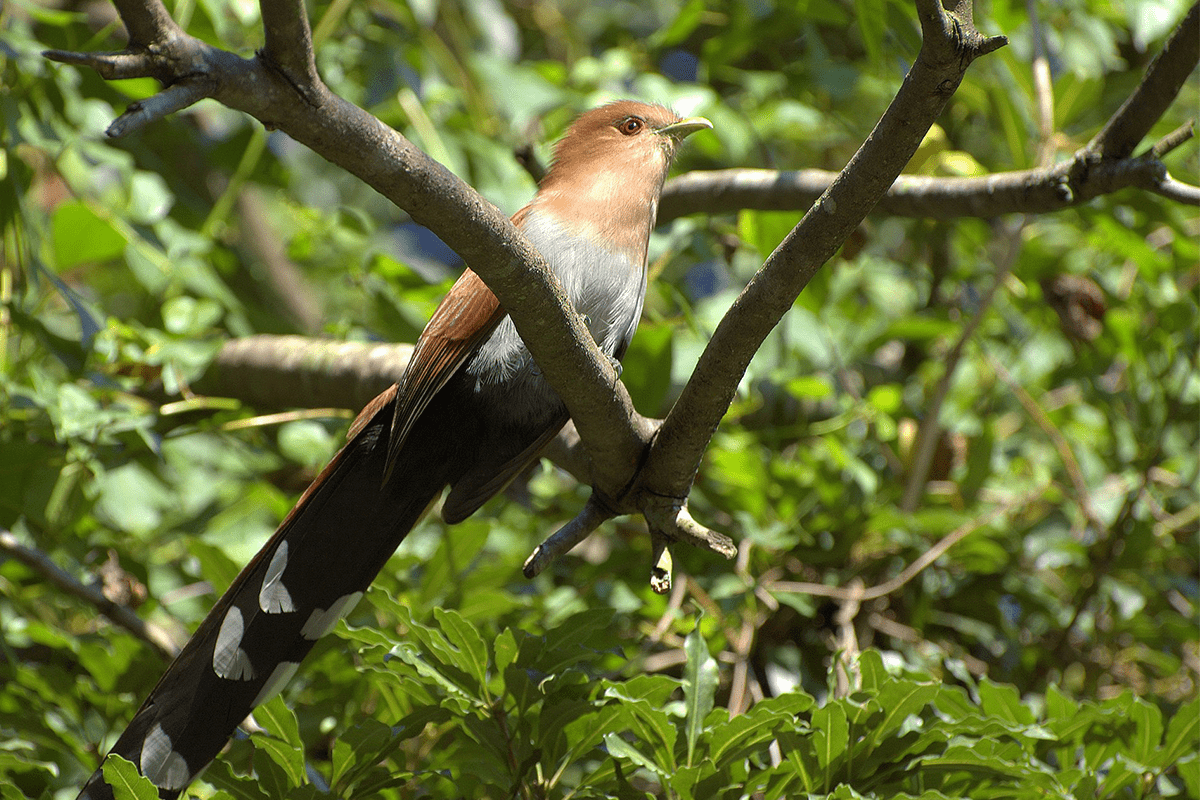The squirrel cuckoo does not look like a squirrel. Except maybe for the fact that both squirrels and squirrel cuckoos have fun tails.
The squirrel cuckoo is fairly large in the world of birds. It’s nothing like the size of a scarlet macaw for instance, but if you averaged out the size of all of the birds in Costa Rica, it would come in on the above average side.
They are brown on top, with brown wings and a brown head. Their underparts are gray. They have a slightly curved yellow break and little dark eyes that look at you like they know what you’re up to. Their most notable feature is their extremely long tail which consists of brown feathers with a white tip on top and alternating black and white feathers underneath.
If the squirrel cuckoo doesn’t resemble a squirrel, then what’s up with the name? The name comes less from what they look like and more from how they act. Squirrel cuckoos eat small creatures hiding in the treetops. They famously dine on caterpillars, even those aggressive-looking ones with all the spines, but they’ll also happily scarf down katydids, cicadas, spiders and small lizards.
While searching for their well-hidden prey, squirrel cuckoos hop around the canopy and run along branches in a manner that immediately brings their furry namesake to mind.
Squirrel cuckoos are found just about nationwide in Costa Rica, and they are pretty common. So if you’re reading this in Ticolandia, step outside and start surveying your trees because you’ve got a decent shot at seeing one.
I encounter squirrel cuckoos frequently in the wild. They are very vocal birds, so sometimes they attract my attention with their calls, but most of the time it’s that squirrel-like movement that catches my eye. I have absolutely no scientific information to base this on, but I think squirrel cuckoos are intelligent.
The way they return my gaze from the branches above makes me think they’re thinking, ‘I see you buddy. I’m going to keep an eye on you.’ And that’s what they often do, they’ll squirrel-bounce from branch to branch, following me as I walk to check my camera traps.
I’ve been told that in Guanacaste they’re also known as viudas (which sounds like be–you–das, all said very quickly together). This translates to widow in English. They said the reason for this is that when you see one, somebody you know is going to die. Which is a real bummer of a superstition because, like I said earlier, they’re all over the place.
I record squirrel cuckoos frequently with camera traps during the dry season in Guanacaste. That’s because I like to put my cameras on the last remaining puddles of water, and squirrel cuckoos enjoy bathing in those same puddles. They all bathe in the exact same manner – first they look directly at the camera with those beady little all-knowing eyes.
I assume they are thinking, “I bet that guy I saw the other day put this camera here.” Then they flash their big, beautiful tail at the camera, jump into the water, splash for a second and jump out of the water again. Sometimes they’ll repeat the same maneuver several times, then they usually stare back into the lens as if to say “Did you see that?”, and then they finally take off.
Come to think of it, the only squirrel cuckoo videos I’ve ever recorded have come from a water source during dry season. If you don’t believe me, take a look at the following videos from my camera traps.
About the Author
Vincent Losasso, founder of Guanacaste Wildlife Monitoring, is a biologist who works with camera traps throughout Costa Rica. Learn more about his projects at: Instagram and facebook or by email.






